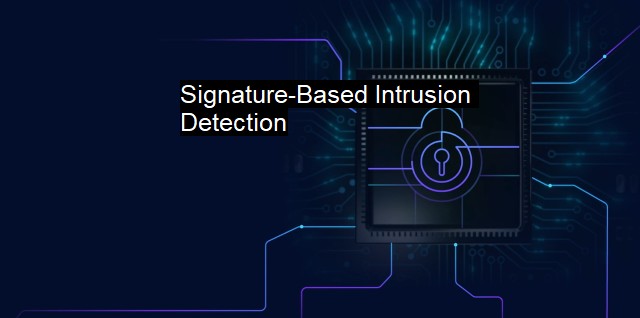What is Signature-Based Intrusion Detection?
Understanding Signature-Based Intrusion Detection: A Comprehensive Guide to Protecting Your Network from Cyberattacks
Signature-based Intrusion Detection is a widely adopted methodology in the realm of cybersecurity and antivirus technologies. this approach toward safeguarding systems is achieved through recognizing patterns, or rather 'signatures' of known threats and promptly responding to them.So, what is an intrusion detection system (IDS)? an intrusion detection system serves as a critical tool for detecting suspicious activities, incidents, or noticeable violations of policies and misuse which pose threats to the safety of a network. There are predominantly two forms of IDS:anomaly based IDS and signature based IDS. This discussion will lean heavily upon comprehending the latter, namely signature-based intrusion detection.
A signature, in the context of signature-based intrusion detection, refers to a set of rules that an intrusion detection system (IDS) or intrusion prevention system (IPS) follows to identify potential threats such as viruses, trojans, and other forms of malware. These rules or patterns are based on specific known malicious traffic attributes such as byte sequences in network traffic, or known malicious instruction sequences used by malware. Accordingly, these attributes or specific data segments incorporated within each 'signature' denote a known threat and are stored in databases. When the IDS or IPS reads the monitored network data stream, it relies on these stored signatures and scrutinizes if any potential parity implies a threat. This methodology essentially banks upon past information and accumulated data, much like an extraordinarily forewarned guard for your system.
Signature-based intrusion detection systems operate by searching for explicit patterns, such as byte sequences in network traffic or identified harmful instruction sequences utilized by malware. When the IDS inspects the network traffic, it uses these signatures to discern actions that represent known threats and immediately sends alerts upon detecting each of these patterns. The signature databases are consistently updated to incorporate details of newly recognized threats and consequently fortify the defense standpoint.
These systems are installed on a single host where the traffic is monitored and logged or on a network where they are stationed to take on network intrusion detection duties that involve analyzing traffic to identify threats. This network-based intrusion detection approach where the entire network is supervised at once works ideally for threats that could emerge from both within and beyond the boundaries of a network.
When should such a system be used? For most cybersecurity applications, employing signature-based intrusion detection is a suitable go-to technique, especially where previously recognized and clearly defined threats are concerned. It has the advantage of being extremely efficient in these contexts due to the systems knowing precisely what they're looking out for. It can promptly pinpoint an intruding entity, provided it matches a stored signature.
Yet, it should be acknowledged that the effectiveness of signature-based intrusion detection systems is largely contingent on comprehensive and updated signature databases; they do not perform adequately when unknown threats or zero-day attacks occur. This is essentially because these systems cannot identify and respond to novel malicious patterns or sophisticated threats not yet included in signature databases, leading to false negatives.
Hence, contemporary security technologies are embracing a combination of intrusion detection methodologies; signature-based detection perfectly captures known threats while anomaly-based and other behavioral techniques step in to handle novel or unknown malicious activities. Indeed, the cybersecurity landscape necessitates the upholding of an evolving protective shield, continually reforming and strengthening itself against sophisticated threats — precisely where a system like signature-based intrusion detection finds its crucial relevance.
Signature-based Intrusion Detection is a critical component of comprehensive cybersecurity strategy, primarily efficient against known threats. As a component of intrusion detection and prevention systems, they offer meaningful contributions to the fortification of network and system security through the identification and prompt response to recognized threats.

Signature-Based Intrusion Detection FAQs
What is signature-based intrusion detection?
Signature-based intrusion detection involves the use of specific patterns or signatures to identify known threats or malicious activity in a network or system. It compares the incoming traffic or files to a database of known signatures to determine if they match any known threats.How does signature-based intrusion detection differ from other intrusion detection methods?
Signature-based intrusion detection relies on specific patterns or signatures to identify threats, whereas other intrusion detection methods, such as anomaly-based detection, look for deviations from normal behavior in the network or system. Signature-based detection may be less effective against newer, previously unknown threats, but it can quickly and accurately identify known threats.What are the benefits of signature-based intrusion detection?
The benefits of signature-based intrusion detection include the ability to quickly identify known threats and respond to them appropriately, as well as the ability to reduce false positives by using specific signatures for known threats. It is also a cost-effective approach to cybersecurity, as it does not require significant computational resources.What are the limitations of signature-based intrusion detection?
One limitation of signature-based intrusion detection is that it is only effective against known threats, so it may not be able to detect new or previously unidentified threats. Additionally, attackers can use tactics such as encryption or obfuscation to evade detection. Finally, maintaining an up-to-date database of signatures can be a challenge, as new threats are constantly emerging.| | A | | | B | | | C | | | D | | | E | | | F | | | G | | | H | | | I | | | J | | | K | | | L | | | M | |
| | N | | | O | | | P | | | Q | | | R | | | S | | | T | | | U | | | V | | | W | | | X | | | Y | | | Z | |
| | 1 | | | 2 | | | 3 | | | 4 | | | 7 | | | 8 | | |||||||